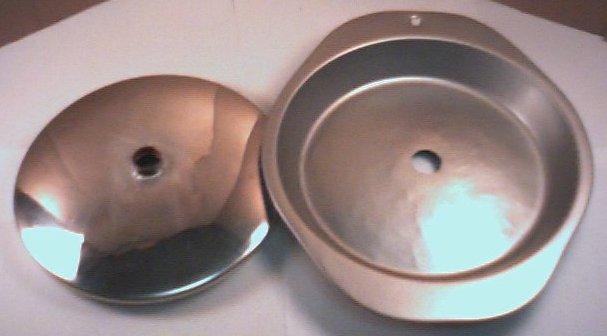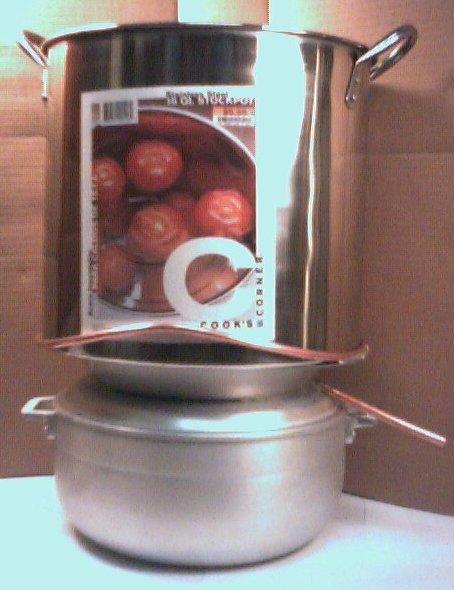
| |
 |
![]()
 Notes on construction out of commonly available parts: In
general make the bottom boiler pot about 3 times smaller in
capacity than the top pot. This will insure the top heats up to
max before the bottom runs out of water. This assumes one
fills the bottom about 2/3 or more of it’s height with water
before starting. It is important that the bottom boiler pot have
a lid that fits snugly (doesn’t let steam out easily). The lid
should be rounded such that it is higher in the center than the
edges. The lid should not be made out of glass but be made
of some metal that allows for ease of making a large hole in
the center.
Notes on construction out of commonly available parts: In
general make the bottom boiler pot about 3 times smaller in
capacity than the top pot. This will insure the top heats up to
max before the bottom runs out of water. This assumes one
fills the bottom about 2/3 or more of it’s height with water
before starting. It is important that the bottom boiler pot have
a lid that fits snugly (doesn’t let steam out easily). The lid
should be rounded such that it is higher in the center than the
edges. The lid should not be made out of glass but be made
of some metal that allows for ease of making a large hole in
the center.
I found between 4 and 4.6 quarts to work well for the bottom
pot. The diameter of the bottom pot is not two important as
long as it is stable when in use (wont easily tip over). Typically
it is 8” to 10” in diameter. If you use much bigger than that it
tends to interfere with the output pipe coming out the side of
the pie pan.
The diameter of the upper pot is constrained by the choice of the pie pan and turns out to be about 10” to 10.75”. The top pot needs to end up stable and held into
place so will not easily slide off. Height of each pot is not too important. I found between 12 and 16 quarts capacity to work well for this pot. I used it without a lid.
Don’t plan on anything much bigger than this it is too dangerous too move when empting. It is heavy and the water will slosh if you move rapidly. Warning: Scalding
hot water accumulates in the top pot during use. Empty it with extreme care. I used leather gloves and moved extremely slow. This pot is heavy. If you have it --
wear water repellent heat protective clothing possibly an apron in case this accidentally spills in the process. The choice of the pie pan is important in that one needs
to solder to it and the extra extended lips on the Pie Pan helps to hold the upper pot in place. The sides being tapered help point the output pipe in the right
direction See the photo at top. With added soldered on flanges I believe in a pinch any pie pan would work.
 Light weight Construction: (for back packing use. Total weight is 2 lb 5 oz. see photos
on previous page). Note: Being light and portable these pots above are very soft and
will bend easily. One should take care to insure this does not happen. I then found
some pots made out of SS and thicker aluminum. It end up being a little more than
twice the weight but is defiantly more durable.
Light weight Construction: (for back packing use. Total weight is 2 lb 5 oz. see photos
on previous page). Note: Being light and portable these pots above are very soft and
will bend easily. One should take care to insure this does not happen. I then found
some pots made out of SS and thicker aluminum. It end up being a little more than
twice the weight but is defiantly more durable.
Heaver duty construction: (for stable location or back pack use. Weight about 4 lb 14 oz.). See photo at right.
Offered by Mike.